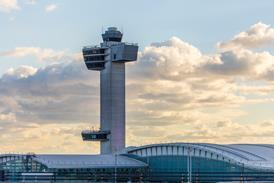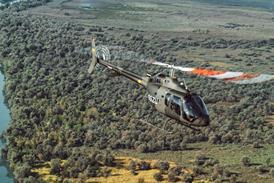Guy Norris/LOS ANGELES
CFM International (CFMI) and arch rival International Aero Engines (IAE) are again heading for the record books. After an astonishingly successful year for both in 1997, the orders have continued and, by mid-1998, look as if they might already surpass significantly those of the previous year.
"I imagined the marketplace would have slowed down by now, but instead we've got firm orders for more than 250 engines so far this year worth $1.5 billion," says IAE president, Barry Eccleston. "The order book already exceeds 1997, which itself was a record year. We'd set ourselves a target for building between 250 and 300 engines every year, so we have already broken that," he adds.
Eccleston's euphoria is equalled by CFMI president, Gerard Laviec, who has seen his company take firm orders valued at around $3.5 billion for more than 650 CFM56s in the first four months of the year. CFMI had targeted sales of around 900 engines for 1998 following last year's rush of orders which amounted to 1,150 powerplants worth more than $5 billion. "We weren't planning to get more orders than the best year we had [1996 with 1,280 engine orders], but it seems there is still a huge demand," he says.
The picture is even more encouraging for both manufacturers in overall order terms for all engines so far this year. By mid-May, more than 1,200 engines had been ordered, compared to around 600 at the same stage in 1996, the best year on record.
"Not only do we have a 53% market share in terms of engines ordered, but we have a 55% share of aircraft units so far in 1998," Laviec says. IAE comes second in the rating with a respectable 21%, while Pratt & Whitney has 10.8%, GE holds 8.5% and the Rolls-Royce proportion is around 7.1%. Although both the GE and R-R shares have since changed, with the recent Singapore Airlines Airbus A340-500 and Lufthansa 747-400 orders, the overwhelming narrowbody trend remains intact.
Unlike IAE's orderbook, which is totally made up of V2500s for the Airbus narrowbody types since the termination of MD-90 production by Boeing last year, the CFM tally continues to be heavily influenced by the CFM56-7 for the Next Generation 737 family, for which it is the sole supplier. Of 287 firm and option aircraft sales announced by CFMI to date, some 157 are for CFM56-7 engines to power 737s. The remainder, including 26 options, are for Airbus A320 family members. CFMI's biggest single win was a $600 million order from Southwest Airlines, which ordered 61 Next Generation 737s earlier in 1998. Its largest Airbus order was from Iberia, which selected the CFM56-5B/P to power 50 firmly ordered and 26 optioned narrowbody family members.
The highlight of IAE's year, meanwhile, has been the order late in April from three Latin American carriers for a combined total of 88 A319 and A320s, with 87 options, in a deal potentially worth $2.3 billion. The contract, signed with Grupo Taca, LanChile and TAM Brazil, was the biggest single order in the consortium's history and is described by Eccleston as "a landmark deal". San Salvador-based Grupo Taca, with 14 V2500-powered A320s already on order, bought an additional 30 aircraft and added 30 options. LanChile, based in Santiago, ordered 20 airliners with 20 options, while Sao Paulo-based TAMBrazil ordered 38 aircraft and placed options on an extra 37.
Earlier in the year, IAE also picked up more business from United Airlines, its biggest customer, which ordered 20 V2500-powered A320s and 10 A319s, extending its Airbus narrowbody fleet to 111. The start of the year was also bolstered when International Lease Finance selected the V2500 for 40 of the 50 A320 family aircraft ordered in 1997. The deal helped IAE edge closer to dominance of the A320 market, and with the Latin American agreement, the scales finally tipped in its favour to give the consortium 56% of the year's Airbus sales in terms of units sold.
As a result, IAE is looking at increasing production to build 300 engines a year. "This supports roughly a 60% market share if Airbus builds around 20 to 22 a month. So if they ramp up production, then so will we," says Eccleston.
CFMI is continuing its production increase, mostly in response to the explosion of Next Generation 737 sales, which have now reached 901 with the addition of orders in May from Alaska Airlines, American Airlines and Delta Air Lines. The rate has risen from 750 in 1997 to a planned 950 this year. "The trend will probably stabilise at around 1,000 a year for the next three to four years," says Laviec.
IMPROVING THE PRODUCT
While both manufacturers are aware of the market pressures to churn out engines virtually as a "commodity", the need to maintain a technological edge is not neglected. From IAE's perspective, this may seem even more important, given Pratt & Whitney's recent decision to develop a V2500 replacement called the PW8000 geared turbofan. "P&W [an equal partner in IAE with R-R] is still fully committed to the V2500," says Eccleston. "Most of our efforts are aimed at improving time on wing, reliability and reducing maintenance costs," he adds. A reduced emissions combustor is also planned in the longer term.
CFMI, meanwhile, remains committed to developing a wide-ranging series of technology improvements for the CFM56 which will enable it to produce a next generation engine with 15-20% lower cost of ownership, 20% lower maintenance costs, up to 50% lower emissions, and almost 7% lower fuel consumption than the -5B/P.
CFMI maintains that the new technology drive would have been made with or without the threat of the PW8000. "We will match the PW8000, and be better because of our customer base, proven reliability and basic centreline architecture," Laviec says, adding: "The risk is much greater without a conventional centreline design. We should be close on performance, but on maintenance costs we should be better."
Most forecasters have reached a consensus on a market potential of between 13,000 and 15,000 new aircraft with at least 90 seats over the next 20 years. Of these, between 60% and 70%, or more than 9,000 aircraft, are expected to be narrowbody types, ensuring that the engine bonanza may well continue.
Source: Flight International























